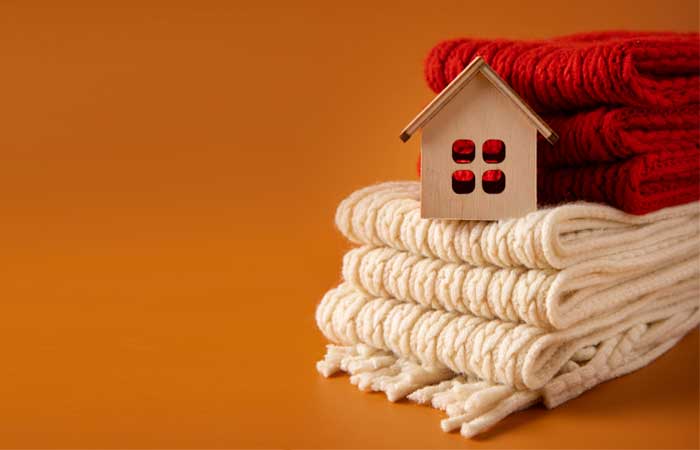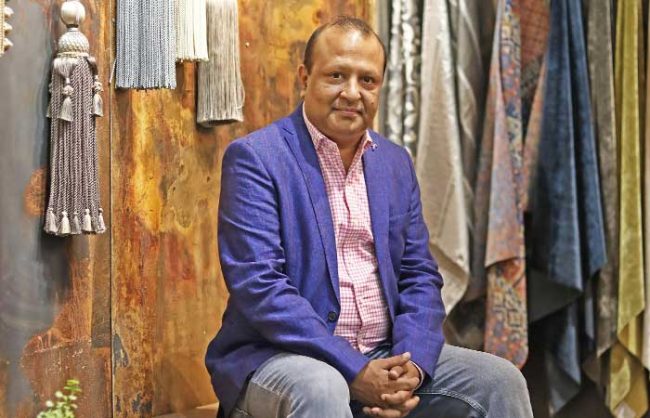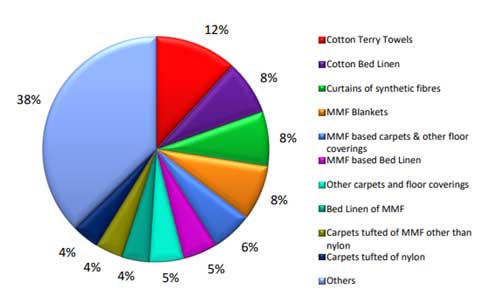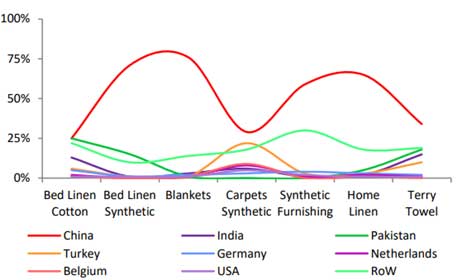
Haven at ‘Home’
Despite the severe challenges posed by global uncertainty, India’s home textile sector saw a significant export volume increase in FY24. Divya Shetty examines the factors behind this rise and its potential to revive the Indian textile industry.
India’s export volumes for Home textiles have increased Y-o-Y in FY24 as per Ministry of Commerce and Industry. In FY24, the performance of the players in the Indian Home Textiles Industry improved on a Y-o-Y basis as the export demand, after declining over 1HFY23 on reduced competitiveness due to high-cost cotton, recovered from 2HFY23 onwards and remained stable over FY24.
The United States, ranked as the world’s second-largest importer of home textiles, holds a significant 31 per cent share of global trade. Factors such as China+’s initiatives and the ban on Xinjiang cotton have benefited India, leading to a notable increase in India’s share in US imports of various cotton products. Specifically, India’s share in US imports of cotton sheets rose from 50 per cent in CY19 to 59 per cent in CY23, while for cotton terry towels and other towels, it increased from 39 per cent to 44 per cent. Similarly, India’s share in US imports of cotton pillowcases grew from 53 per cent to 58 per cent during the same period.
While the domestic demand growth continues to be strong, the export demand is also increasing. This is supporting high-capacity utilisations for the domestic players. “The continued inclination of the key importing nations towards China-Plus-One sourcing strategy has augured the export volumes from India in the past and it shall continue to support growth in export volumes over the medium term. India has a dominant market share in the US imports for home textiles which is on an increasing trend. Further, stable input costs have aided in restoring export competitiveness of Indian products in FY24 and is expected to continue in FY25 on likely balanced demand-supply scenario in the domestic as well as international markets,” informs Shradha Saraogi Garg. Additionally, sustained high capex is being incurred by the domestic players to expand capacities in order to cater to the increasing export avenues supported by China-Plus-One and concluded/ongoing Free Trade Agreement negotiations with importing nations.

“Stable input costs have aided in restoring export competitiveness of Indian products in FY24 and is expected to continue in FY25y”
– Shradha Saraogi Garg, Associate Director, India Ratings and Research
Exploring market trends
India’s growing urban population and increasing middle-class segment play crucial roles in driving the home textile market. As urbanisation progresses and living standards improve, there is a rising demand for home textiles such as bedding, towels, curtains, and upholstery. The consistent increase in disposable income among Indian consumers has spurred expenditure on lifestyle items, particularly home textiles. With greater purchasing power, consumers are increasingly inclined to invest in superior quality and visually appealing home textile products, thereby stimulating market expansion.
“Government initiatives such as “Make in India” “Atmanirbhar Bharat”, “Production Linked Incentives” (PLI) for various Manufacturing Sectors and supportive policies aimed at promoting textile manufacturing have provided impetus to the home textile industry. Incentives for domestic production, infrastructure development, and skill enhancement programs have encouraged investment in the sector, contributing to its growth,” says Kailash R Lalpuria. These factors are driving growth in the Indian home textile industry. Additionally, here are the trends observable in this emerging sector.

“Online retail offers convenience, a wide variety of choices, and competitive pricing, making it increasingly popular among Indian consumers.“
– Kailash R Lalpuria, Executive Director & CEO, Indo Count Industries
Rising focus on sustainable products: The Indian home textiles industry is embracing sustainability, with a growing demand for organic and eco-friendly products. “Our company is thriving in the domestic market, driven by demand for premium, sustainable home textiles. Key opportunities include expanding eco-friendly product lines and leveraging advanced technology for improved design and production,” explains Rohit Khemka. Consumers are increasingly seeking products made from organic or recycled materials, as well as those manufactured using environmentally friendly processes.

“Multifunctional and smart textiles that blend aesthetics with technology are gaining popularity. Artisanal and handcrafted designs reflecting cultural heritage are also in vogue.”
– Rohit Khemka, Founder, RR Décor
Unconventional designs: Using unconventional materials in home decor items like rugs, poufs, pillows, and throws can elevate a space in surprising and stylish ways. “The main trend that we are seeing in home textiles for this year is about using a lot of colours, patterns and pattern on pattern. People are using huge wallpapers. A lot of experimental stuff is happening in upholstery and textiles. Even we are getting a lot of requirement for bold colours in flooring. There is use of textile in an unconventional ways in homes in the form of wall rugs. Wall rugs have become a big thing in addition to hand-done wall decor and cabinet panels,” opines Anushka Ahuja.

“Now is the time that India is finally focusing on home decor. So, we are getting different requirements for different kind of products and different things people want to experiment.”
– Anushka Ahuja, Co-Founder of Studio by Agni
Design minimalism: One more trend in consumer behaviour as far as the home segment is concerned people are going in for much cleaner looks and more minimalism. “The wabi-sabi look continues to be in consumers’ minds where they prefer adding colour through rugs, art and accessories. Whereas the home colours are muted in tones of beige and white, keeping the furniture slightly more airy and minimalistic. Furthermore, modern consumer behaviour is to shift to the subtle splash of colours to uplift home space. There’s a trend of shift towards colour elements and art through rugs. Adapting to current trends and colour palette a challenge, but we stand at the forefront of research and designs to stay on the top of the game,” states Smriti Choudhary.

“Rugs as a segment is actually a sustainable product because we usually use very minimal machines which results in zero carbon footprint.”
– Smriti Choudhary, Brand Director of Cocoon Fine Rugs
Preference for branded and luxury products: There is a clear shift in consumer preferences towards branded and designer home textile products. Recognisable brands provide assurance of quality and design, while designer collections appeal to those looking for unique and stylish options. This trend has led to the growth of both domestic and international brands in the Indian market. “The demand for luxurious, customised products that resonate to consumers’ need for individuality is increasing in the Indian home textiles market. A developing trend that reflects a desire to bring the outdoors in is the incorporation of elements from other cultures and environment,” comments Smita Joshi.

“We are constantly looking into new materials and technology that can help us reduce our environmental impact.”
– Smita Joshi , Vice President, Home Textiles and Design Expert, Nesterra under Sutlej Textiles
E-commerce surge: The expansion of e-commerce platforms has reshaped the home textile market in India. Online retail provides convenience, a broad range of choices, and competitive pricing, making it increasingly popular among Indian consumers. E-commerce has also enabled smaller and niche players to enter the market, intensifying competition and fostering innovation.
Promising categories

Figure 1: Market shares of categories within the home textile industry
Source: Wazir Advisors, Systematix Institutional Research
The bed linen category, encompassing cotton and Man Made Fabric (MMF)-based bed linen, blankets, etc., dominates the global home textiles trade, holding a substantial 25 per cent share as of CY22. It is anticipated that the increasing improvement in consumer living standards and the preference for luxury and branded linen will continue to drive growth in this segment of home textiles (see Figure 1). Additionally, the bath linen segment is said to gain significant market share, driven primarily by growth in the hospitality industry. According to a Research and Markets report, the global market for bed and bath linen is projected to grow at a compound annual growth rate (CAGR) of 8.7 per cent from CY22 to CY30, reaching $ 165.7 billion by CY30 from $ 85.2 billion in CY22.

Figure 2: Global home textiles commodities export share
Source: Wazir Advisors, Systematix Institutional Research
India currently holds a modest 13 per cent market share in cotton bed linen trade, indicating substantial growth potential. Conversely, in synthetic bed linen, India exports just 1 per cent of the global market, with China dominating at 71 per cent. For synthetic carpets and furnishing exports, India’s shares are 6 per cent and 1 per cent respectively. With increasing global demand for Man Made Fabric (MMF)-based products, India has promising opportunities to align its export offerings with global needs and significantly expand its market share in these sectors (see Figure 2).
Global market: Recovered or still sluggish?
The demand for Indian Home Textiles in the international market has recovered and remained stable over FY24. There is a potential upside in export demand over the medium term given curtailed consumer spending on discretionary products as the key importing nations are witnessing subdued economic growth. India’s market share in US imports over 2023, especially for cotton bedsheets and terry towels, was strong at round 58 per cent and 43 per cent respectively. Further, despite lower Y-o-Y volume imports of home textile products in the US over 2023, India’s export volumes have witnessed lower proportionate decline as compared to China indicating improving market share of India supported by China-Plus-One sourcing strategy adopted by major importing nations.
“Over 4M2024, the US import volumes have increased on a Y-o-Y basis indicating green shoots of recovery in demand. Additionally, during 4M2024, India’s volume imports increased in higher proportion leading to India’s improving its market share further for cotton bedsheets and sustaining the same at high levels for terry towels. The logistics disruptions caused by escalating geo-political issues have impacted the imports in US albeit over the short-term, leading to delayed shipments, increased logistics costs and deferment of orders. However, the core demand is expected to grow at a modest rate and the import volumes are likely to sustain as the supply chain rebalances and the disruptions are addressed,” adds Garg.
While the global export market appears to be recovering, companies indicate that it will take some additional time for complete recovery. Lalpuria informs, “The on-going crisis around the Red Sea shipping route, resulting from Houthi attacks on commercial vessels, and Israel – Hamas War may impact various industries in India. The Red Sea route via the Suez Canal accounts for 50 per cent of the country’s exports and 30 per cent of imports. This disruption is significantly impacting Indian trade, especially with the Middle East, Africa, and Europe. It’s important for us to continue monitoring these situations and adapt their strategies accordingly.”
Choudhary adds, “2023 was slightly low in terms of slower consumer behaviour because of the pandemic. Some projects were on-going which were completed, and ultimately we managed to stabilise our revenues. We have high hopes for 2024.”
Opportunities on the cusp
While the global textile industry continues its recovery phase, the Indian home textile industry has the potential to accelerate this progress, buoyed by numerous opportunities ahead.
Many large global retailers have embraced the ‘China+1’ strategy, expanding their sourcing and manufacturing operations beyond China to diversify and reduce dependence. In key home textile consumer markets such as the US and EU, there is a gradual shift in import preferences from China to India. This shift is driven by concerns over forced labour in China’s Xinjiang region, which prompted bans on Xinjiang cotton and considerations of labour costs.
India’s home textiles industry is poised with immense potential, being the second-largest exporter globally with approximately 10 per cent export share. Free Trade Agreements (FTAs) play a pivotal role in enhancing India’s textile exports by reducing or eliminating tariffs and other trade barriers. Over the past five years, India has strengthened its global trade presence by signing 13 FTAs. Noteworthy agreements include the India-Mauritius CECPA, India-UAE Comprehensive Partnership Agreement, and India-Australia Economic Cooperation and Trade Agreement. Recently, India concluded a Trade and Economic Partnership Agreement (TEPA) with the European Free Trade Association (EFTA) nations comprising Iceland, Liechtenstein, Norway, and Switzerland after 15 years of negotiations. This agreement is expected to significantly bolster growth in India’s textile industry, particularly in terms of critical inputs, technology, and opportunities for product development.
Additionally, after experiencing a period of high prices, cotton prices in India have stabilised. This development is promising news for manufacturers sourcing raw materials from the country.
Therefore, it can be asserted that the Indian home textile sector is acting as a lifeline for the Indian textile industry amid global uncertainty. It also presents an opportunity for other businesses to enter this burgeoning market if they aim to thrive and position their country as a global leader in textiles.




